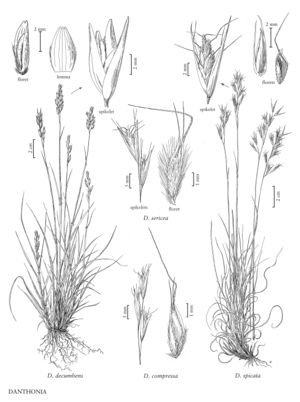Difference between revisions of "Danthonia compressa"
FNA>Volume Importer |
FNA>Volume Importer |
Revision as of 21:34, 16 December 2019
Culms 40-80 cm, disarticulating at the nodes when mature. Sheaths glabrous, rarely sparsely pilose, usually reddish above the nodes; blades to 30 cm long, 2-4 mm wide, flexible but not curled at maturity, glabrous, sometimes scabrous, uppermost cauline blades erect to ascending. Inflorescences with (4)6-17 spikelets; branches usually flexible, usually divergent, sometimes strongly so, after anthesis; lower branches with 2-3 spikelets; pedicels on the lowest branch as long as or longer than the spikelets. Spikelets (7)10-16 mm. Calluses of middle florets about as long as wide, convex abaxially; lemma bodies 2.5-5 mm, pilose over the back, sometimes sparsely so, margins pilose to beyond midlength, distal hairs 0.5-2 mm, apical teeth 2-4 mm, aristate, (1/2)2/3 or more as long as the lemma bodies; awns 6-10 mm; anthers to 2.2 mm. Caryopses 1.7-2.6 mm long, 0.7-1.1 mm wide. 2n = 36.
Distribution
Conn., N.J., N.Y., D.C, W.Va., Ark., Del., N.C., S.C., Tenn., Pa., N.S., Ont., P.E.I., Que., Va., Mass., Maine, N.H., R.I., Vt., Alaska, Ala., Ga., Md., Ohio, Mich., Ky.
Discussion
Danthonia compressa grows in open and semi-shaded areas, including meadows, open woods, and woodland openings. Although not a true pioneer species, it may sometimes occur as a weed in perennial crops. It is restricted to eastern North America.
Selected References
None.
